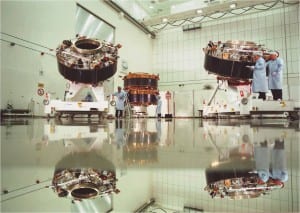Royal Society Summer Science Exhibition 2011: Sun, Sky and Speech
By zcqsd60, on 12 July 2011
How are aeroplanes affected by ‘space weather’? Why are the Northern Lights interesting other than for pretty photos? How far does surrounding noise impair your ability to hear speech?
Three different groups of UCL scientists looked into precisely these questions at this year’s Royal Society Summer Science Exhibition last week. Along with more than 20 stands, the exhibition hosted a number of events throughout the week looking at various topics in more depth, in the form of panel discussions or Café Scientifique debates.
I have just completed a UCL Natural Sciences MSci degree, majoring in Astrophysics, so had a natural inclination towards the astrophysics stands during my visit, and was particularly excited by the Solar Flares and Northern Lights Café Scientifique last Saturday.

This Café Scientifique event was chaired by Dr Lucie Green of UCL’s Mullard Space Science Laboratory (MSSL), and the panel contained Dr Jim Wild, a Reader in Space Plasma Physics at Lancaster University’s Department of Physics, and Captain Bryn Jones, the CEO of SolarMetrics Limited and a Captain at Virgin Atlantic Airways.
The event had an introduction, a break then a discussion between the panel and the audience. The introduction covered the concept of space weather, descriptions of the two main types of solar activity and the hazards they can cause to air travel around the world. Dr Wild explained that solar flares are like ‘flashes’ of light, while coronal mass ejections (CMEs) occur when material from the outer layers of the Sun is thrown out in various directions, which Dr Wild nicely summarised as “a billion tons of electrically charged material moving at a million miles an hour”.
Captain Jones then took this background science and covered the three main ways that an aircraft can be affected by this space weather while flying: communication failure, radiation exposure and the future problem of being susceptible to GPS failure. Interestingly, although slightly worryingly, only the first of these currently has a fully tested and widely implemented procedure in case of occurence.
After the break, audience members were invited to ask questions, and Dr Green joined the panel in answering some of the queries. These covered a huge range of topics, from concerns about confusion from general media coverage of solar activity to education programmes for pilots on solar activity and exactly how a CME could knock out the National Grid. There is an audio recording of the entire event available from the Royal Society website, or here.
 Unfortunately for me, once this event had finished I only had an hour and a half to look round the exhibition before it closed. I didn’t manage to see everything but two of the UCL contributions did catch my eye, Aurora Explorer and Noisy World.
Unfortunately for me, once this event had finished I only had an hour and a half to look round the exhibition before it closed. I didn’t manage to see everything but two of the UCL contributions did catch my eye, Aurora Explorer and Noisy World.
Aurora Explorer was a collaboration between nine different institutions (including UCL) and focused on the four-spacecraft Cluster mission. Cluster is looking at the Earth’s magnetosphere: how exactly it protects us from the Sun’s solar wind and how, by doing so, it produces the aurorae humans have nicknamed the Northern and Southern Lights.
The stand had a replica of the four spacecraft that make up Cluster (scaled at one tenth of their actual size), arranged in the tetrahedron formation in which they orbit. Cluster was launched in 2000 and since then has been revolutionary in the process of understanding Earth’s magnetosphere. This is because having four spacecraft orbiting in formation allows scientists to study the three-dimensional structure of the magnetosphere, and how it deflects particles towards Earth’s poles to cause the aurora.
The Noisy World stand was run by UCL Speech, Hearing and Phonetic Sciences and the UCL Ear Institute. They had a particularly good interactive activity that involved picking out information from speech when competing noises were being played at the same time. This could be done by two sets of four people at a time and, by taking part as a group, you worked together to combine skills and improve your final score. I am proud to say my group could distinguish information given at 28.2 times lower volume than the competing sentence, which we were told is a very good score.
The scientists on both Aurora Explorer and Noisy World were clearly passionate about their subjects and engaged with visitors of all ages. They were equally comfortable explaining scientific concepts to me, as a recent science graduate, and the seven year-old daughter of a friend I was with.
I think the best summary of the exhibition is that when asked to identify what could be improved for next year, everyone I visited with immediately agreed it should be open for longer than one week!
3 Responses to “Royal Society Summer Science Exhibition 2011: Sun, Sky and Speech”
- 1
-
2
Scary wrote on 13 July 2011:
You didn’t check out the LCN running the Schrodinger’s cat on a chip stand? They had some great merch, the cutest logo, and some interesting responses to the question: ‘What would you do if you could do two things at once?’
 Close
Close



What a wonderful article summarising a brilliant event.